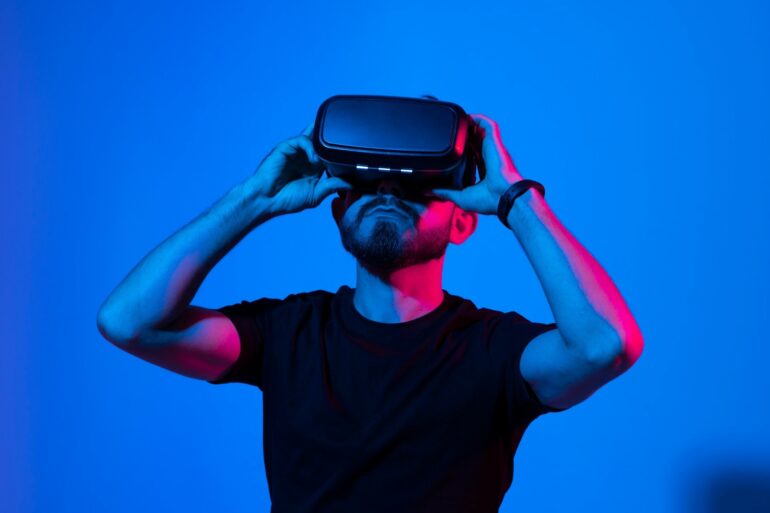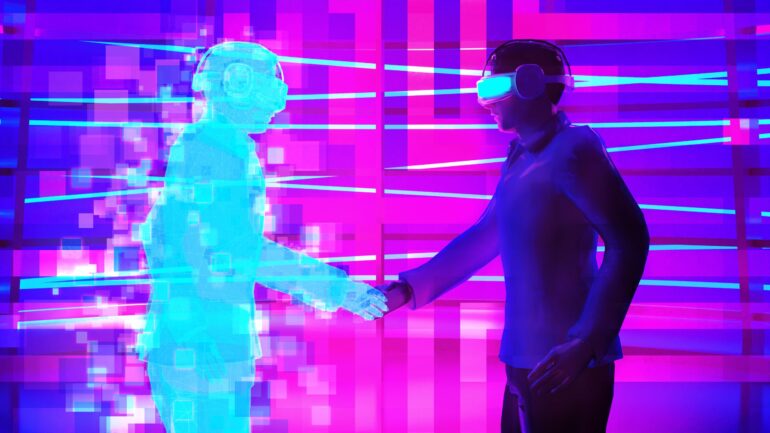Since COVID-19, virtual reality applied in virtual offices is a must-have technology in real estate and other businesses because it has a positive effect on the mental well-being of their workforce. Virtual meetings or video conferencing have become more advanced. The Metaverse unlocks new options by creating a multi-virtual communication environment that allows users to combine the real world and virtual environment for new experiences.
Virtual Reality allows you to experience real situations by immersing you in a virtual world through 3D design that is manufactured in a virtual office. The workers create images, sounds and spaces to move around in a virtual environment. This technology will change the workspace of the virtual office to an advanced level.. The Metaverse technology will raise awareness of occupational risks in virtual reality and will create user experiences that engage feelings and emotions and immerse users in a virtual environment through helmets, goggles, and sometimes screens onto which images are projected.
Metaverse: What Is It And How Does It Work?

Metaverse refers to an open digital space where users can work, play and communicate through personalized avatars. It is like a video game where users live their virtual lives online as usual but through an increasingly immersive experience instead of browsing. It is an evolution of our way of interaction and communication online using spatial locations turning the Internet into a social space rather than today’s isolated experiences. The Metaverse represents a major shift in how we interact with technology, raising a host of legal issues best handled by a lawyer expert in the realm of the metaverse and Web3.
It is like the 3D Internet shared virtual space that combines physical and digital virtual reality by using technologies such as virtual reality (VR), Internet of Things (IoT), space technology, artificial intelligence (AI), augmented reality (AR), head-mounted displays (HMD) and 5G. However, these technologies are device independent, so they are always present whether they are in the Metaverse or not.
Connecting with Metaverse is easier than with the Internet. A kind of virtual space or virtual universe that welcomes users in a similar way to the Web like in social networking platforms. In it people create online profiles and interact with other profiles, but this time in an immersive 3D environment allowing for multiple Metaverses that users can interact with. The Metaverse offers a “personal avatar”, which is your digital persona to other Metaverse users.
Through it, you can walk and interact with other visitor avatars as if you were walking through a real city and talking to real people. Wearing a VR headset not only allows you to talk to other users, but also allows them to interact naturally, such as reaching out, shaking hands, or performing various tasks together. Hence, users feel like they are in a real place with real people, rather than communicating through a video screen that focuses on looking directly into a webcam. In the digital world, this presence is so real that we need to strengthen our boundaries, just as in the real world, eliminating disturbances or noises.
How Is Metaverse Different From Virtual Reality?

The two terms VR and Metaverse are interlinked as the long-term success of both depends on each other. Without an easy-to-use VR/AR HMD, the Metaverse is just the Internet. Virtual reality can be used as a standalone experience, completely separate from the online world. At the heart of the Metaverse is that experience is connected in some way through visual and interactive experiences. VR apps/games do not need to connect to any other source. Another major difference is that the Metaverse can be easily accessed without the need for virtual or augmented reality. It can be explored through a browser on any computing device. On the other hand, VR can only be experienced with a VR HMD and a VR controller or with hand tracking.
VR technology and the concept of “Metaverse” are so closely related that they seem similar having no differences, but they are different. Virtual and augmented reality devices allow users to physically interact with software in real space. This programming interaction has much in common with but is not limited to, what is known as the Metaverse. One of the major differences between the two technologies is that the Metaverse needs interconnected skills between applications that represent the digital world. The future will see the limits of our technology to the point where the distinction between the digital and physical worlds is blurred.
How Will Metaverse Shape The Future Of Business?

There will be a lot of changes with Metaverse, especially from its present form because you will have access to a 3D virtual world where a lot of things could happen. This will unfold thousands of applications ranging from video games to remote work, socialization, productivity and communications. Through it, the brand will be able to create a 3D environment and fill it with activity. So, the appearance of the Metaverse is eagerly awaited.
A new generation of 8-16-year-olds already interacting in the Metaverse and paying as much attention to physical life as virtual life, they must learn to coexist in a different physical-digital world than today. However, it will be a difficult process because It’s not as easy as creating a website and will take about 10 years for small companies to start conquering the Metaverse.
The bottom line Is that the social impact of the “new internet” has certainly changed the way we live. Initially, the Internet was based on scripts and text, then images and videos were incorporated, and now virtual and augmented reality used in virtual offices will provide the level of immersion that futurists have dreamed of. Undoubtedly, technology companies create a lot of buzz around the Metaverse because they are interested in developing technologies that complement and enhance physical and digital realities. But aside from the hype, thanks to the fusion of these technologies, the possibilities seem limitless. These technologies have advanced unexpectedly in recent years.
